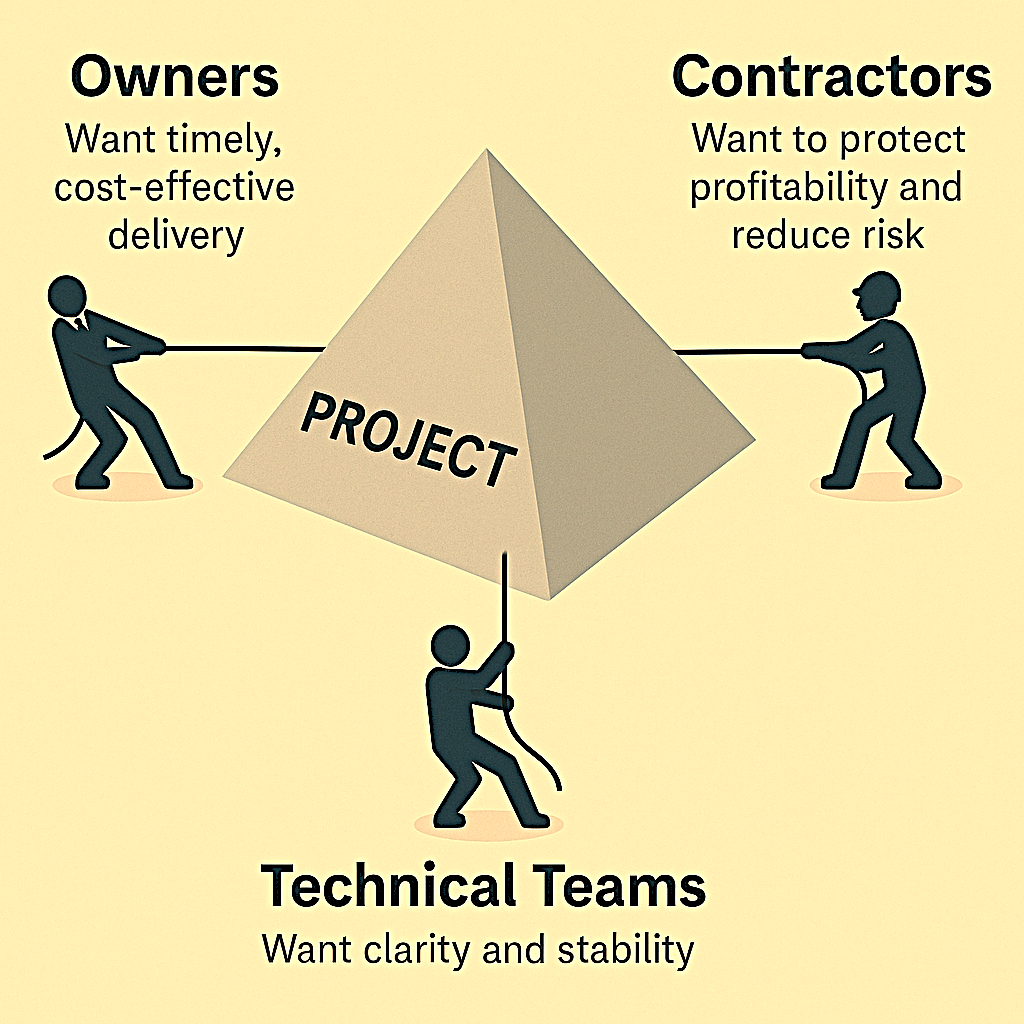
Introduction
In every project—whether large or small, complex or straightforward, infrastructure or industrial—change is inevitable. It may come from design refinements, stakeholder demands, regulatory shifts, or unexpected site conditions. And yet, despite this certainty, project teams often find themselves unprepared when change arises.
The reason? Because many organizations still treat change as a disruption to manage later, rather than a process to strategize from the beginning. Even when change procedures exist, they’re often misaligned, poorly communicated, or inconsistently applied. In some cases, changes are not properly identified or documented. In others, they escalate into disputes due to misaligned expectations, vague contract clauses, or delays in stakeholder communication.
In our work across capital projects and delivery environments, we’ve seen these risks play out repeatedly. Whether it’s missed opportunities to log valid changes, or conflicts over cost and time impacts, change becomes a point of stress, conflict, dispute, or even major financial loss rather than a strategic opportunity.
According to Prosci, projects with poor change management are 6 times more likely to fail than those with excellent change practices.
PMI repeatedly (such as PMI’s 2018 & 2023 Pulse of the Profession reports) identifies Scope Control as one of top 3 drivers of project success.
This article shares practical insights from our six-part LinkedIn series on project change management with some updates. It combines lessons learned, real project stories, and the framework we’ve developed—the Tiered Change Trigger Model—to help teams lead change proactively, communicate clearly, and avoid the traps that lead to failure.
Understanding Change and Change Management
Change in projects refers to any modification, deviation, or adjustment to the originally approved plans including scope, schedule, cost, quality, risk allocation, or contractual obligations. Change management is the structured process by which these deviations are identified, evaluated, approved (or rejected), implemented, and documented. Change management applies across all phases of a project—starting from bid phase through initiation and planning, design, procurement, execution, and into commissioning and closeout.

Changes often become a source of conflict due to the conflicting interests between stakeholders:
- Owners want timely, cost-effective delivery.
- Contractors want to protect profitability and reduce risk.
- Technical teams want clarity and stability.
Without a transparent and fair change evaluation and negotiation process, these differing interests can lead to delays, disputes, or even claims.
How to Avoid This Conflict:
- Establish shared definitions of what constitutes a change
- Ensure all parties agree to a common set of baselines and risk allocations
- Embed early-stage communication checkpoints to resolve issues before they escalate
- Maintain transparency in the decision trail and documentation
When done right, change management isn’t just risk mitigation—it becomes an opportunity for collaboration and shared value.
Embracing Change: Turning Challenges into Opportunities
Too often, change is viewed only as a threat—something to resist, avoid, or control. But in many cases, it can become an opportunity to:
- Expand scope or services
- Demonstrate responsiveness and value to the client
- Get involved in additional phases or services
With the right structure and client trust, well-managed changes can reinforce relationships, showcase capability, and grow the business—especially in progressive and partnership-based delivery models.
Why Change Management Fails in Many Projects
Most failures in change management are not due to a lack of policy—they stem from structural gaps, human dynamics, and reactive decision-making:
- Teams have processes, but no one follows them.
- Field staff bypass approvals to avoid delays.
- Project Managers hesitate to raise changes, fearing client conflict.
- Communication failures, lead to misunderstanding and client resistance.
- Contracts lack clear baselines, exclusions, or governance appendices.
- Clients expect changes to be implemented without impact.
- Change is treated as “coordination” instead of risk.
- Negotiation devolves into bundled compromises, not structured review.
This leads to delayed approvals, denied claims, and escalating risk—where the cost of uncertainty can be high.

The Crucial Missing Steps in Many Projects
A. Identification of Change Management Strategy
The change management strategy should be defined early—ideally during the bid phase—based on the risks inherent to the chosen delivery and contractual model. For example, in Time and Material (T&M), Integrated Project Delivery (IPD), or progressive models, there is often a higher expectation for flexibility and adaptability, which can reduce formal change control procedures. However, this perceived flexibility can lead to rapid, undocumented changes, placing pressure on teams, creating frustration, and resulting in untracked scope shifts with little to no compensation.
In many of these projects, contracts lack formal change management clauses, and the absence of a clear and transparent RACI model often causes duplication of efforts, accountability gaps, and financial losses. Identifying these risks early allows project teams to proactively design mitigation strategies—such as role clarity, communication workflows, and interim approval structures—to maintain control in dynamic project environments.
PMI:
“Project COMPLEXITY affects scope creep, and the percentage of projects with high complexity is on the rise."
B. Contract Alignment & Closure of Gaps
Depends on the delivery and contractual model and associated risks, a comprehensive change management protocol may include a contract alignment checklist that covers:
- Approved baseline schedule and cost
- Approved/agreed list of the assumptions, exclusions and interface risks
- Documented quality, digital delivery, and applicable technologies, and Building Information Modeling (BIM) requirements (such as LOD and LOI).
- Reporting requirements, KPIs and
- Change Management procedures, documentation and approval protocol
- A clear RACI or decision-making matrix
- Agreed turnaround times for client inputs and approvals
- A clear deliverables list and milestones
- Performance standard

If the contract doesn’t provide these, they must be developed in the Project Execution Plan and approved by the client. Without this foundational alignment, even valid change requests may be delayed, disputed, or denied.
A Note to Project Owners and Their Representatives
While it’s essential to respond promptly to valid change notices, we also recognize the need to be vigilant against false or strategic change claims—especially in contracts awarded based on aggressive pricing or those who try to recover their losses due to their poor performance. Some vendors may intentionally underbid and later attempt to recover costs by issuing inflated or exaggerated change notices. These tactics may be based on:
- Poor initial baselines
- Unverifiable productivity assumptions
- Vague language in deliverables
How to Protect Against It:
- Require submission of fully traceable documentation (logs, memos, drawings, deliverables)
- Conduct internal reviews of schedule and cost impact analysis
- Clarify contract assumptions and exclusions during bid evaluation
- Include formal change review boards or third-party audits for high-value changes
- Implement a robust change management process
- Set clear contract terms
- Foster open communication
- Allocate a contingency fund in the project budget to cover potential change claims.
That said, not all changes are illegitimate or avoidable. In dynamic project environments, even well-planned scopes evolve. Dismissing valid changes or treating all claims with skepticism can lead to unnecessary conflict, stalled progress, and legal costs. Emphasizing fairness in change evaluation and balanced risk allocation helps all parties complete the project successfully and minimizes adversarial behavior. A collaborative approach to change protects relationships, encourages transparency, and avoids costly escalation.
The Solution? Tiered Change Trigger Model
To address these patterns, we use a practical framework called the Tiered Change Trigger Model—a structured, scalable approach tailored to the reality of project delivery.

Governance:
- Tier Classification: Each project and change is assigned a tier based on scale, complexity, contract model, and risk exposure. This prevents over-engineering on small changes and underreacting to large ones, in addition to benefiting from the appropriate review and approvals to avoid risks.
- Defined Triggers & Thresholds: Each tier sets clear boundaries: what qualifies as a change, what thresholds demand escalation, what authority levels apply, and how quickly response is expected.
- Role-Based Training: Training, is not one-size-fits-all. Technical staff learn how to flag changes, control team learn how to analyze the impacts comprehensively, PMs learn escalation paths, executives understand trade-off thresholds.
Bid, Initiation and Planning Phases:
- Change Management Strategy Identification: The change management strategy should be defined early—ideally during the bid phase and be considered during initiation (negotiation) and planning phases—based on the risks inherent to the chosen delivery and contractual model.
- Contract Alignment & Closure of Gaps: The model includes a checklist of essential enablers: baseline schedules, exclusions, RACI matrices, quality standards, client dependencies. If the contract doesn’t include them, they’re built into the execution plan—with client sign-off.
- Robust Change Management Protocol: Identify a clear change management procedure, comprehensive impact analysis, documentation, templates, tracking and reporting tools, required approvals, and roles & responsibilities. Include the final agreed version in Project Execution Plan.
Execution Phase:
- Embedded Communication Protocols
To help PMs and field teams raise concerns early without fear, we script neutral language and encourage early-stage client dialogue—recorded and traceable. - Realistic Negotiation Strategies: No more bundled settlements under pressure. Instead, case-by-case discussions based on commercial risk, relationship maturity, and contract flexibility.
- Tracking the Changes and Reporting: Ensure all changes are meticulously tracked and documented. Establish clear reporting mechanisms to maintain transparency and accountability throughout the project lifecycle.
Closing Phase:
- Closing Out: Focus on completing all deliverables related to each approved change and meeting contractual obligations. Ensure thorough documentation and communication to facilitate the smooth closing of approved changes.

Real World Examples
Case 1: $2M Overrun Avoided in Design-Build Water Project
In a municipal water upgrade under a lump sum contract, the client failed to provide land access for a critical tie-in. No access timelines had been defined in the contract.
The client insisted it was “just a coordination issue.” The project team, applying the Tiered Model, classified it as a Tier 2 change (critical path impact + >1% cost exposure), documented daily impacts, and escalated using a structured pre-notice.
The result: $1.4M recovered through scope adjustment and $600K through milestone renegotiation—avoiding legal escalation and preserving trust.

Case 2: $1.6M Rework Prevented in EPC Wastewater Project

The contractor relied on outdated reference drawings, which conflicted with updated standards issued by the client’s authority—but never formally documented.
The issue triggered rework, redesign, and procurement delays. The team applied the model, traced documentation gaps, escalated with QA logs and design memos, and secured $1.1M recovery with timeline flexibility, avoiding formal disputes.
Case 3: Hidden Project Expansion Misclassified as a Change
A brownfield feasibility study quietly evolved into a full EPCM execution under the same contract. No team reassessment. No appropriate risk analysis. No governance review and approval. The PM with no EPCM experience, eager to maintain momentum, bypassed Customer Relationship Management (CRM) and Project Management Information System (PMIS) registration and treated it as a change. The result: vendor delays, schedule misalignment, missed regulatory windows, client dissatisfaction and formal claims, and financial losses due to late delivery penalties and unresolved scope expansion. Had the Tiered Model been in place, this would’ve triggered:
- A formal re-initiation
- Risk reassessment and stakeholder realignment
- Governance visibility
This case isn’t rare. Many teams take shortcuts to avoid bureaucracy—only to uncover major risks later.
Conclusion
Change is not the issue. But unstructured, unaligned change is. Projects succeed when:
- Teams understand what change really means
- Contracts and expectations are aligned early
- Approval thresholds match the project’s scale and risk
- People are trained and supported—not left to guess
A strong contract and robust governance process will allow teams to differentiate between legitimate change and opportunistic behavior—protecting both project integrity and commercial fairness.
If your team is stuck in reactive change loops, or your contracts aren’t protecting you, it may be time to rethink your model. The Tiered Change Trigger Model is more than a framework—it’s a mindset for proactive, aligned, and transparent delivery.
Notes
* If you’d like early access or to pilot the model in your project, get in touch and book one hour free consultation session today.
**To support implementation, we’re preparing a set of customizable resources, including:
- Tiered Change Trigger Framework & Escalation Matrix (Excel)
- Change Readiness Assessment (Checklist)
- Change Communication Scripts (PDF)
- Contract Clause Gap Checklist (Word)
- Training Roadmap by Role (PPT/Doc)
- Change Notice Templates and Logs (Excel/Word)
References
- Prosci. The Correlation Between Change Management and Project Success.
https://www.prosci.com/blog/the-correlation-between-change-management-and-project-success
- PMI. Pulse of the Profession 2018 Report.
#ProjectManagement #ChangeManagement #ContractStrategy #ProjectGovernance #CapitalProjects #ProjectControls #PMO #RiskManagement
Do you have any questions?
Click and book a 60 minutes free consultation meeting today.
